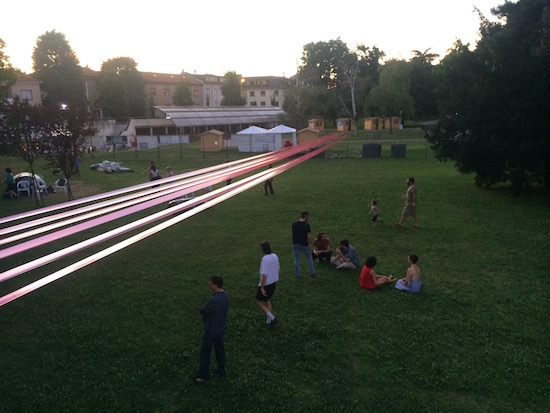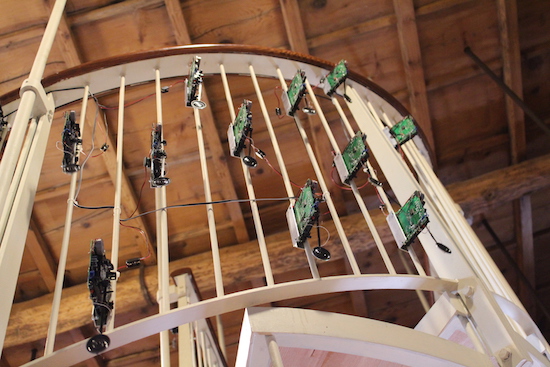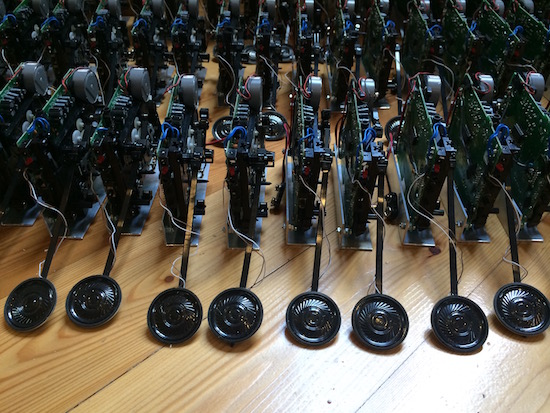"Why not? It would be very nice to organise a school about sound, about sound studies." Attila Faravelli pauses momentarily, contemplating the stout Milanese pizza on the plate in front of him. "We are very much into theory about sound."
Sound artist, composer, performer, Faravelli is a key part of the team behind Frequente – "not the co-founder," he hastens to add, "but I’m a regular contributor" – a roving organisation, dedicated to sound art in the city of Milan. Active since the spring of this year, Frequente have curated site-specific projects by the likes of Seiji Morimoto, Stephen Cornford, Gábor Lázár, and Jake Meginsky. "It aims," according to the website, "to deepen and share the practice of sound, attentive with regard to contemporary art, architecture and music."
As Faravelli indicated to me, it’s not just about installations and live presentations, but what he called "a wider approach", embracing lectures, theory, and practice-based research. Though based in part at the studio shared by Faravelli and Frequente co-founder Nicola Ratti at Standards, a venue for experimental music just outside the centre of Milan, and with strong links to the art gallery O’ across town, Frequente’s activities have no fixed abode. Recent activities have taken them to the grounds of a stately home in the wine-producing regions of Nova Milanese, several kilometres outside the city.
To get a fuller picture of the range of Frequente’s interests and activities, I spoke to curator Gaia Martino, the fourth part of the team, along with the three members of the group Tilde (Faravelli and Ratti plus Enrico Malatesta).
"I met Attila, Enrico, and Nicola at O’ in Milan, four years ago. At that time I was working on a daily basis at O’ and SoundOhm [the mail order stockist run by Fabio Carboni from the basement of O’]. O’ is daily a spontaneous incubator of ideas and a very pivotal centre for people working in the art field in Milan and seriously interested in the experimentation. O’ is not only a physical space but it is a community of people constantly in move to share energies and knowledge.
"Of course I knew Attila, Enrico, and Nicola for their work before coming to Milan, but it is at O’ that we had the opportunity to get to know each other personally and, day by day, understand that we have things in common in terms of interests, research and approach. I immediately recognized the potential of their attitude and started to suggest some opportunities to explore. Then, Enrico asked to me to work for Tilde, their collaborative project of spatial practice through sound, bringing in my contribution as curator.
"This is the starting point of our collaboration – that flowed into Frequente when Nicola, one year ago, proposed to us to start a long term collaboration together."

What was the idea behind Frequente when you first put the organisation together?
"The peculiarity of Frequente is its inner diversity. Each of us has a different background and different priorities of interest. We decided to to propose Frequente as an art organisation and independent research centre starting from this diversity between us.
The intention was to introduce an Italian pole to the international network of venues specifically addressed to the sound arts. The art policy in our country is not sufficiently attentive to the relation between institutions and independent experimentation and this is why we have a high level of expression in academic research but much less links to the art practice, and vice versa.
"Meanwhile, there are authors in the field of sound arts whose sophistication of language goes beyond live performance and the display of sound installations. They want to share and introduce a dialogue as an expression of their practice and with the desire to contribute to a common discourse over the arts, but in Italy there are no real opportunities capable of welcoming these experiences. Frequente is born with the aim to respond to this requirement.
"From my part, the efforts are addressed to opening a reflection about what auditive culture means. In recent years, contemporary art has demonstrates a growing attention to sound at different levels. Cultural work related to sound is increasingly wide within contemporary art, but they do not always pay attention to the context. The consequence is that, beyond the niche audience that is familiar with sound perception, people end up “listening through the eyes” – that is, they understand sound experience through the visual cognitive skills that connotes our culture.
"This situation does not reflect the nature of the medium itself: sound is first of all a nutritious exercise for the listener. The artwork is in fact realised with the active presence of the listener and through an active approach to the environment: the language of sound is ontologically relational by its own nature. So, it is essential give the opportunity to the audience to find and improve the skills useful to this exercise of presence that is listening."

Between the four of you, do you all have particular roles within Frequente?
"As I said before, the strength of Frequente is the diversity of our creative processes and experiences. There are not specific roles, but every time we know perfectly who will be the best at doing something with a precise purpose. We respect our reciprocal space of action – even though we do not always agree.
"Nicola has a practical approach to the things. He decides, then he does. It is he who organises concerts and live performances at Standards Studio, who makes contact and communicates with artists, and who is able to immediately see the shape of an idea. He has the gorgeous quality of simplifying, in terms of less is more.
"Currently, Enrico’s focus is on didactic activities. His approach to sound studies is unique and his talent as an artist corresponds with a rare capability as a teacher to define the method, the practice, and the purpose [of his activities]. We often use a vocabulary taken from Enrico’s expressions – he is an author, in a very authentic and clear sense.
"Attila, with all his creative chaos included, is a real genius. His research on sound traverses experience coming from all directions: praxis, anthropology, philosophy, walking, reading, listening, knowing people… This quality makes him the reference for all Frequente’s choices. He deals with theoretical contents, technical issues, and practical results. He acts as a catalyst for Frequente, proposing always fascinating ways of thinking about sound.
"From my part, I coordinate timelines and deadlines and I take care of the coherence of Frequente as organic project. I’m a curator and I’m interested in being attentive to the dialogue at every level: with the audience, the critics, the context, the sponsors, and with the contemporary art scene – never forgetting to support my colleagues’ paths as independent artists. I guess I act as a mediator between their creative personalities. I try to create connections."

What plans do you have for the future of Frequente?
Frequente was born with the aim to support artistic research on sound, both theoretical and practical. Our main project is to establish an independent didactic experience, conceived as a series of intensive courses per year, across sound and spatial practices. It would be an experimental school aiming to open up perspectives on sound studies, proposing to participants different strategies of engagement with sound.
"On the other hand, we would like to see our organisation become a pivotal node within the international network, a place to share experience with the purpose of spreading ideas about artistic sound researches – not only as a private thing, but as part of a dynamic, collective body of knowledge..
We would like to encourage mobility, sustaining residencies focused on auditive culture for artists from abroad and being able to support a number of scholarships for Italian artists and researchers.
"Then, we would experiment with different modalities of presenting and displaying sounds, questioning the content at the same time as the form. Beyond electroacoustic performances, we would like to explore along with the artists through editorial projects, site specific installations, walkings, live performances, architectural interventions, and more."
Frequente will be presenting Lucrecia Dalt at Standards, MIlan, on 22 September


